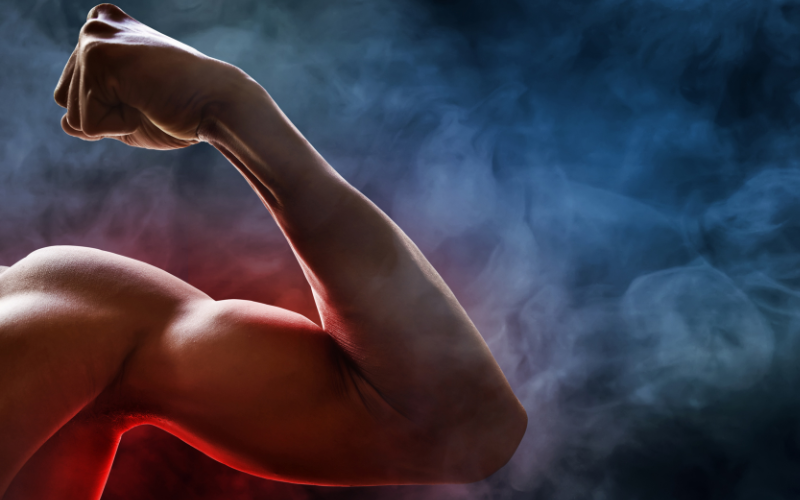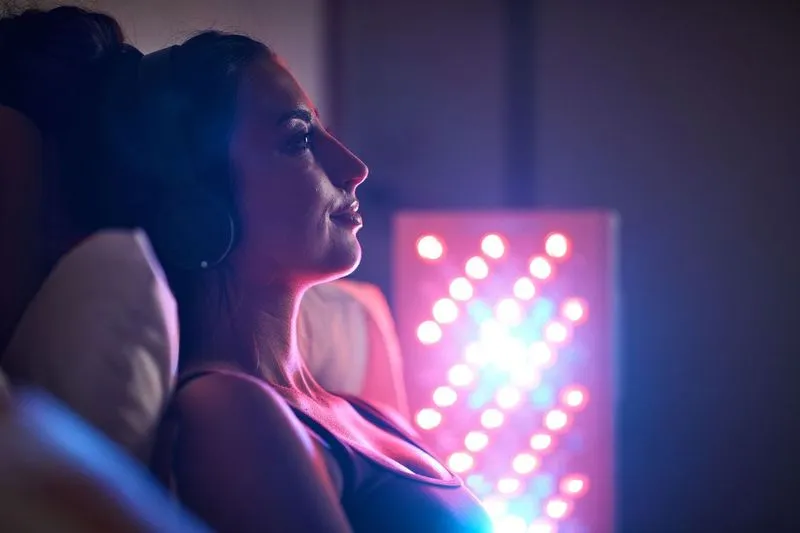The red light therapy (using LED panels) is experiencing growing enthusiasm among the high-level athletes and the fitness enthusiasts to accelerate healing and muscle rebuildingThis natural treatment is an effective solution that not only helps athletes recover faster after exertion, but also benefits individuals in rehabilitation, getting back in shape, or looking to improve their muscle condition. What exactly are the benefits of these LED panels for muscle recovery, and what does science say about it? A growing number of studies have looked into the question, and the results are promising. In this article, we explore how red light affects muscle tissues, the scientific evidence of its effectiveness, and how LED panels Platinum LEDStand out from other brands. Finally, a FAQ will address common questions about the use of red light therapy for muscles.
How does red light promote muscle recovery ?
When we expose the skin naked to a red or infrared light emitted by a LED light therapy panel, the wavelengths penetrate the tissues and are absorbed by the muscle cells, particularly by the mitochondria (the energy plants of cells). This light absorption triggers a series of beneficial biological mechanisms:
- Increase in cellular ATP: Red light stimulates the production ofadenosine triphosphate (ATP) the mitochondria, providing more energy to muscle cells. This energy is essential to support the cell repair process, promote muscle rebuilding, and allow tissues to regenerate after a weight training session, for example. Better-nourished cells in Energy recover more quickly and function optimally.
- Reduction of oxidative stress and inflammation: Red LED treatment increases the production of natural antioxidants, which reduces oxidative stress in the muscles. This results in less cell damage induced by free radicals. Additionally, red light helps to reduce inflammation by accelerating the elimination of metabolic waste and modulating the inflammatory response, thus contributing to a faster recovery.
- Improvement of blood circulation: Under the effect of LEDs, The blood vessels in the muscles dilate and the blood flow increases locally. This improved blood supply allows for more efficient nourishment of the muscle tissues as well as the deeper cells, providing them with more oxygen and essential nutrients. At the same time, the elimination of lactic acid and toxins is facilitated, which speeds up recovery and alleviates muscle soreness after exertion.
- Stimulation of collagen production: Red light therapy stimulates collagen synthesis in muscle and connective tissues. Collagen is an essential protein for the structure and repair of muscles, tendons, ligaments, and cartilage. By increasing collagen production, red light actively supports the healing process, helping to strengthen and repair damaged tissues (including in case of injury) more quickly.
Thanks to these combined effects – more cellular energy, less oxidative stress, better circulation, and stimulated tissue regeneration – red light helps muscles to repair faster and more efficiently. In summary, it creates an optimal environment for recovery, muscle rebuilding, injury prevention, and the improvement of athletic performance.

Scientifically proven benefits for muscle recovery
Many scientific research confirm that LED panels represent a promising new technology for improving muscle recovery in a natural and effective way. These devices work in depth, with measurable beneficial effects on reducing inflammation, accelerating the tissue repair process, and decreasing muscle fatigue.. A major review from 2017, encompassing 46 studies and 1,045 participants, concluded that red light photobiomodulation provides a significant advantage to competitive athletes. The authors even suggest that this therapy could offer athletes an "unfair advantage" by significantly improving their recovery process and optimizing their sports performance, thus allowing them to train more intensely and more frequently. In other words, The better a muscle recovers, the harder and more often it can train – a crucial asset for staying at the top of one's discipline.
The positive effects are not limited to elite athletes. A meta-analysis published in 2018 involving 39 controlled clinical trials (861 participants) confirmed that photobiomodulation improves muscle endurance and reduces Fatigue associated with exercise, particularly when applied before exertion. More recently, a 2021 narrative review identified 25 human studies showing effects ergogenic and protective red light, even describing this new technology as the "key to success for high performance and optimized recovery." These scientific proofs strengthen the credibility of red light therapy as a tool for muscle recovery.
Concretely, the studies have observed several measurable benefits following the use of LED panels on muscles: a reduction in lesion markers muscle enzymes such as creatine kinase (an enzyme released during muscle fiber damage), faster recovery of muscle strength, as well as a pain relief and a reduction of the delayed onset muscle soreness (DOMS) after training. By improving circulation and the elimination of lactic acid, red light also acts as an excellent way to relieve muscle tension, reducing stiffness and post-exercise pain. Athletes treated with red light generally report less than muscle soreness and a sensation of accelerated recovery, allowing them to resume training earlier and in better conditions.
Muscle and tendon injuries can also benefit from LED phototherapy. In case ofElongation, muscle tear, or muscle contusion, The local application of red light helps reduce inflammation and edema, while accelerating the regeneration of damaged muscle fibers. Physiotherapists are increasingly incorporating this treatment to complement rehabilitation, observing faster healing of soft tissues and a reduction of the risk of recurrence from injury. In short, whether it's about recovering after an intense workout, relieving muscle pain, avoiding overtraining, or healing from an injury, the red light LED panels provide valuable assistance for a more effective muscle recovery Fast and complete. By actively supporting muscle regeneration, they allow athletes to aim for better performance while respecting their physiology.
The advantages of Platinum LED panels compared to other brands
Faced with the growing popularity of red light therapy, many brands are offering LED panels on the market. Platinum LED stood out in this field, particularly with its BioMax series, acclaimed by independent comparisons. Based on the data from an in-depth comparison of the best panels of 2024, here are the distinctive advantages of Platinum LED panels compared to others:
- Higher irradiance power: Platinum LED panels offer exceptional light intensity, with irradiance measured up to ~90 mW/cm² at 15 cm of distance. This power level is among the highest on the market, ensuring deep penetration of light into the muscles. This intensity allows for targeted action on the affected areas, maximizing the effectiveness of the treatment. In comparison, most competitors typically reach between 70 and 80 mW/cm², making Platinum one of the most effective devices for delivering the energy needed for recovery.
- Large coverage of treatment: The flagship model BioMax 900 from PlatinumLED is a large panel of about 30 cm wide (12 inches), offering an illumination area of approximately 23 cm useful. This allows for the treatment of large muscle areas in a single session (for example, the entire back or both legs simultaneously), whereas many competing panels that are narrower (~15–20 cm wide) require multiple applications to cover the same surface. Greater coverage results in time savings and increased efficiency for the user.
- Unique multi-wavelength spectrum: PlatinumLED BioMax panels emit a spectrum on 7 different wavelengths (red and infrared). This combination notably includes the wavelength 810 nm in infrared, recognized for its profound effects on tissues. Most competing panels are limited to 4 or 5 wavelengths, and some do not include the 810 nm. By covering a broader spectrum, PlatinumLED targets a wider range of tissues (surface of the skin, deep muscles, joints), maximizing the therapeutic benefits on muscle recovery.
- Proven cutting-edge technology: PlatinumLED is at the 8and generation of panels (BioMax 2024 series), reflecting years of optimization. The brand has consistently topped independent comparative tests (first place in the category in 2019, and again in 2024). This experience translates into reliable and innovative devices, with a well-thought-out design (possibility of assembling multiple panels, ergonomic mounting systems) and meeting the strictest safety standards. Few competitors can boast such a track record and continuous improvement of their products over time.
In summary, the PlatinumLED panels stand out for their high power, large treatment area, full light spectrum, and expert-approved quality, making them a top choice for athletes and demanding users seeking the best light therapy for their muscles after intense physical exertion, and wishing to optimize their recovery to achieve their sports goals more quickly.
> We have established an exclusive partnership with PlatinumLED, a global leader in red and infrared light therapy, to provide you with 5% discount on all of their panels. In addition to their exceptional power, wide wavelength spectrum, and scientifically validated results, PlatinumLED now has a warehouse in Europe., which greatly facilitates delivery. You thus avoid customs fees, import-related delays, and receive your equipment quickly, without any unpleasant surprises. An effective, simple, and accessible solution to integrate therapeutic light into your daily life.

FAQ – LED Panels and Muscle Recovery
Q: Does red light really help with recovery after sports?
R: Yes. Numerous studies confirm that red light accelerates muscle recovery after exertion. By improving fiber repair, reducing inflammation, increasing blood circulation, and promoting wound healing, it helps muscles recover more quickly from training or intense effort. High-level athletes use it to string together sessions with less fatigue. It is not a miracle solution, but rather a scientifically validated tool to optimize post-exercise recovery.
Q: How long should a LED panel be used for muscles?
R: Red light therapy sessions are generally short, around 10 to 20 minutes per day per treated muscle area. It is recommended to target the muscle or muscle group being worked on for about 15 minutes. Beyond 20 minutes on the same area, additional benefits are limited, as the tissues have already absorbed all the useful energy. It is better to prioritize the regularity of the sessions rather than an excessive duration on a single occasion.
Q: How often can one have red light therapy sessions for recovery?
R: For optimal muscle recovery, it is recommended to use the LED panel several times a week. During periods of intense physical activity (daily training), a daily session of red light can be beneficial. For maintenance use, 3 to 5 sessions per week are generally sufficient. The important thing is to be consistent over time – for example, every day or every other day – in order to maintain the cumulative benefits on the muscles.
Q: Should red light be used before or after training ?
R: Both are possible and complementary. Before the training, a brief exhibition (5–10 minutes) The red light on the main muscles involved can serve as a passive warm-up: it increases circulation and muscle flexibility, and could reduce the extent of micro-lesions during exercise. After the training, a classic session of 10–15 minutes helps accelerate recovery by reducing soreness and inflammation. Many athletes combine a short pre-exercise session and a post-exercise session to maximize benefits, promote recovery, and contribute to a sustainable improvement in physical performance.
Q: Is red light therapy safe for muscles?
R: Yes, red light therapy is considered safe and non-invasive. Unlike UV rays, red and infrared light do not damage the skin and do not expose you to harmful rays. Studies have not shown any major side effects on muscles or general health, provided that usage recommendations are followed (reasonable session duration, minimum distance indicated by the manufacturer). It is simply advised to avoid looking directly at the very bright LEDs without protective glasses. In addition to promoting recovery, it can be integrated into a routine aimed at maintaining or improving physical performance, without health risks.
References
- Ferraresi C. and others. (2016). Photobiomodulation in human muscle tissue: an advantage in sports performance? Journal of Biophotonics, 9(11–12), 1273–1299.platinumtherapylights
- Vanin AA. and others. (2018). Photobiomodulation therapy for the improvement of muscular performance and reduction of muscular fatigue associated with exercise in healthy people: a systematic review and meta-analysis. Lasers in Medical Science, 33(1), 181–214.pubmed.ncbi.nlm.nih.gov
- Ailioaie LM., Litscher G. (2021). Photobiomodulation and Sports: Results of a Narrative Review. Life (Basel), 11(12), 1339.MDPI
- Padoin S. and others. (2022). Phototherapy improves muscle recovery and does not impair the repeated bout effect in plyometric exercise. Journal of Strength and Conditioning Research, 36(12), 3301–3310.pubmed.ncbi.nlm.nih.gov











